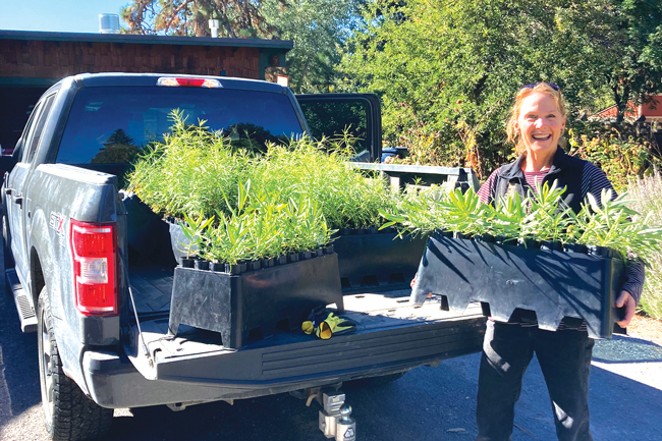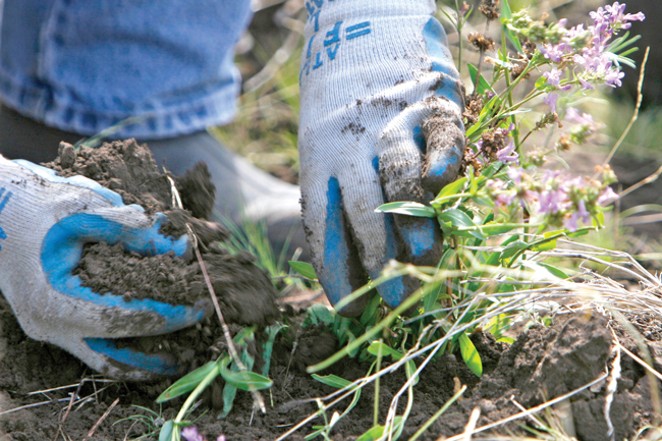Water—or lack thereof—is a hot topic these days. According to the latest Oregon Climate Assessment, more than one-third of Oregon has been in a drought for the last 20 years, and we aren't likely to return to what we all think of as "normal" water conditions. The situation in Central Oregon is especially dire for farmers, ranchers and those who depend on water for their livelihoods. Since we can't keep hoping for rain or epic snow years to change the situation, we all need to adapt to the new normal of a warming planet, which means way less water than we all had 50 years ago. So, what's the average person to do to help? Conserve and adapt your own water use to help our precious, limited supply go further.

There are massive resources online for how to audit and cut your water use around your home, indoors and out. Check out your local city or water provider's website as well, and dig in and commit to cutting your water use by transitioning your home indoors—the Environmental Protection Agency estimates that 70% of our water use is indoors!
Outdoor water use is around 30% of our total usage. However, the EPA cautions that use "can be much higher in drier parts of the country... the arid West has some of the highest per capita residential water use because of landscape irrigation." In Central Oregon, the City of Bend and OSU Extension have several excellent publications about gardening/landscaping with less water, but another way to save water in Central Oregon (the arid West!) and with that water-hungry landscaping, is to transition your yard or gardens to native plants.
Native plants are adapted to a high desert environment, and need less water to grow and thrive. They come in all shapes, sizes and colors and planting them instead of nonnative shrubs and perennials will save water for people and nature. As an added benefit, planting native also helps benefit local pollinators like bees, butterflies and bats, and can provide habitat for local wildlife as well. Native plants, insects and animals need all the help they can get as our climate continues to warm and change!
Again, there is no shortage of online resources for planting native. For example, you can lose yourself in the rabbit hole of Doug Tallamy's site about turning your yard or garden into wildlife habitat. In Central Oregon, Oregon State University Extension has native plant lists and we are lucky to have several native plant nurseries. However, sometimes there is so much information it can be overwhelming. The Deschutes Land Trust has a simple list of 11 pollinator plants to grow to get you started with links to more natives that provide color and nectar all year long.
The nagging question may be, how to get started? Where do you rip out that lawn first? Over the years, the Deschutes Land Trust has planted hundreds of thousands of native plants at our protected lands (and many in our home gardens!) and we've developed some tips and tricks to helping native plants thrive. Location is first! Start small, and find a sunny spot in your garden. Many of our native plants (including wildflowers) love the sun! It doesn't have to be full sun, but your plants will be happiest if they have a decent amount of sun (4-8 hours every day, depending on strength of the sun). If you don't have sun, look for native plants that are shade tolerant or grow in wetter areas, but beware some will need more water in your landscaping.
When planting non-native plants and vegetables, you hear a lot about improving your soil since Central Oregon soil is usually sandy and not very nutrient rich. Luckily, since native plants are adapted to our soils, you don't have to amend your soil. You should consider, however, when you will plant. We all get itchy to garden in the spring, but consider planting your natives in the fall. The Land Trust plants all of our native plants in the fall to take advantage of cooler temperatures and natural moisture that comes over the winter. Fall planting, among other reasons, allows natives to concentrate on growing roots and getting established before hot summer weather arrives.
When you do plant, give your natives space in your garden. It's tempting to shove them all together to look more robust, but young native plants don't like competition from other plants when they're starting out. The same goes for weeds! Keep your native plant garden weed free to help give those natives a chance to get established. If you are planting native milkweed to help the monarch butterfly, plan on giving this plant even more space! Milkweed spreads underground via rhizomes and you don't want to battle it later. Give it the space it needs to create healthy monarch butterfly habitat.
Finally, tend your garden. Native plants (even drought tolerant ones) will need watering in order to establish their roots. This can sometimes take two to three years, but be careful of over-watering: it is very easy to give native plants too much water. Once your plants are established, they won't need as much water and should thrive in our Central Oregon climate helping reduce your overall household water use.








